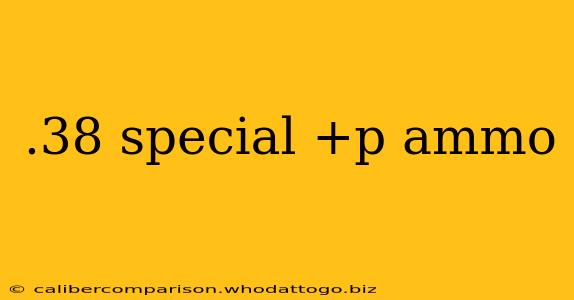The .38 Special cartridge, a venerable round with a rich history in law enforcement and civilian self-defense, has seen numerous iterations. One notable variant is the .38 Special +P, which offers increased power and stopping power compared to standard .38 Special ammunition. Understanding the nuances of .38 Special +P ammo is crucial for anyone considering it for personal defense or target practice.
Understanding +P Designation
The "+P" designation indicates that the cartridge operates at a higher pressure than standard .38 Special ammunition. This higher pressure allows for the use of heavier bullets or faster propellant, resulting in a greater muzzle velocity and, consequently, more kinetic energy upon impact. This translates to increased stopping power, potentially making it a more effective self-defense round.
Increased Power, Increased Responsibility
The added power of .38 Special +P ammo comes with increased responsibility. It's vital to ensure your firearm is explicitly rated for +P ammunition. Using +P ammo in a firearm not designed for it can lead to catastrophic damage to the weapon, potentially causing serious injury or death to the shooter. Always check your firearm's owner's manual to confirm its compatibility with +P loads before using them.
Ballistics and Performance
.38 Special +P ammo typically features a higher muzzle velocity and greater kinetic energy compared to standard pressure loads. This enhanced performance can be advantageous in self-defense situations, potentially leading to faster incapacitation of a threat. However, this increase in power can also result in increased recoil, making it potentially less suitable for individuals with limited shooting experience or physical limitations.
Bullet Weight and Types
.38 Special +P ammo is available with a variety of bullet weights and types, each offering unique characteristics:
- Jacketed Hollow Point (JHP): These bullets expand upon impact, increasing their stopping power and reducing overpenetration. They are a popular choice for self-defense.
- Full Metal Jacket (FMJ): FMJ bullets are designed for target practice, offering consistent performance and penetration. They are not generally recommended for self-defense due to their higher risk of overpenetration.
- Lead Round Nose: These are often used in older revolvers and are generally less effective than modern hollow point designs for self-defense.
The choice of bullet weight and type depends on individual preferences and intended use. For self-defense, JHP rounds are generally preferred for their expanded stopping power and reduced risk of collateral damage.
Recoil and Control
As mentioned earlier, .38 Special +P ammo produces noticeably more recoil than standard pressure ammunition. This increased recoil can affect accuracy and shooting comfort, particularly for new shooters. Proper shooting technique, including a firm grip and consistent stance, is crucial to manage recoil effectively and maintain accuracy.
Choosing the Right Ammo
Selecting the appropriate .38 Special +P ammo requires careful consideration of various factors, including:
- Firearm Compatibility: Always verify your firearm's compatibility with +P ammo.
- Intended Use: Are you using it for self-defense, target practice, or competition shooting?
- Bullet Type: Consider the advantages and disadvantages of different bullet types (JHP, FMJ, etc.).
- Bullet Weight: Heavier bullets generally offer greater stopping power but may also have increased recoil.
Conclusion
.38 Special +P ammo provides increased stopping power compared to standard .38 Special loads. However, it is crucial to prioritize safety and ensure your firearm is rated for +P ammunition before using it. Understanding the ballistics, recoil characteristics, and different bullet types available is essential for making informed decisions about ammo selection based on your individual needs and circumstances. Always consult your firearm's owner's manual and seek professional guidance if you have any doubts. Remember, responsible firearm ownership includes responsible ammunition selection and usage.

